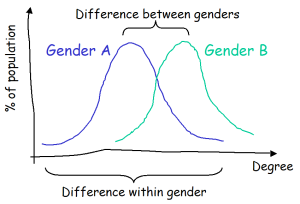I’ve recently been doing a gender course at work. I don’t think it’s because I have been singled out as having gender issues. Perhaps it was just that when people were being nominated, my name was an easy one to say. (I don’t think Lleieusszuieusszesszes Willihiminizisteizzi Hurrizzissteizzi ever had that problem.)
After hearing all about someone else’s view of gender issues, it’s really solidified my own view. I hope I can explain it clearly here. Now, I haven’t experimentally verified this, but it is a testable hypothesis, and seems anecdotally true.
Of all the various personal characteristics, there are those that are directly related to reproduction, and all the rest. For those not related to reproduction (such as height, empathy, strength, ability to multi-task, focus, risk-taking — you get the idea) the characteristics are normally distributed for both genders. This is shown in the following diagram:

The diagram shows how for any particular (non reproduction-based) characteristic, the degree to which it appears in any gender is normally distributed across the population. The conclusion here is that the difference between the genders (as represented by the difference between the average degree of that characteristic for each gender) is less than the difference within a gender (as represented by the spread of degree of that characteristic within any particular gender).
So, treating people in the workplace (or, really any place) as if characteristics that they hold fall anywhere along the spectrum covered by both genders is a good way to ensure that you cover any particular gender well. Certainly, it’s a better approach than relying on characteristics to fall close to the average for a particular gender. In other words, and from the perspective of the male-dominated industry that I’m in, trying to accommodate both men and women is also a good way to ensure that you accommodate a broad spectrum of men.
Okay, excuse my natural devil’s advocate kicking in here. This may or may not be relevant, but it’s something to chew on.
It occurred to me that there’s an assumption built into what you’re saying, namely that your company is hiring “average people”. The problem is that the exponentially decaying tail of the normal distribution means that small changes in the average value can cause (relatively) big changes in the population at extremes.
I couldn’t think of a good illustration of this phenomenon, so here’s a bad one. In the fastest 50% of the world population, a big proportion are female, but in the top 0.000 001% — the fastest olympic qualifiers — 0% are. (Flawed because probably reproductively relevant?)
Better to stick to what I’m good at: allow me to crunch some numbers. Suppose that for a particular characteristic, Gender A’s average is about 0.5% std deviations above Gender B’s — ie, much less than the “spread within the gender”.
If your company is hiring people in the top 50% of the population, then you can expect a gender ratio of about 3:2 (Gender A’s to Gender B’s), which is not particularly significant. But if they’re hiring from the top 1% in that characteristic, then the ratio goes up to 4:1. That’s actually smaller than I expected it to be, given the exponential decay, but you’d definitely notice it in the tea room.
It only gets worse as you hire more and more exceptional people: if your employees are one-in-a-thousands, then its close to 6:1. So, for instance, if floor-traders are selected _purely_ for their aggressiveness, then a significant gender inequality seems statistically likely. If you take this at face value, gender inequality in “extreme occupations” is perfectly defensible. (Though I expect the gender ratio in floor-traders is way more than 6:1).
Obviously, this completely evades any issues of cultural programming, etc, etc, which will likely dwarf the probabilistic effects. Also, it assumes you’re only selecting for one characteristic, probably a poor hiring policy.
I am always a fan of the devil’s advocate. It goes great in devil’s guacamole. No, wait..
For clarity, I meant to exclude reproductive-based characteristics such as.. I dunno.. menstrual frequency or sperm production rate, where one gender will have a spread of degree and the other gender will be zero. Many characteristics, such as voice pitch, amount of body hair, or even running speed, will be influenced by gender but it isn’t something exclusive to only one.
But I accept your point that if you were hiring based on candidates passing a threshold value of a single characteristic, and this was a characteristic that differed between the genders, and you hired sufficiently quantities of people for statistical effects to appear, then you would find yourself with a gender imbalance. Also, if all you cared about was that characteristic, then you would probably not care about the gender imbalance. :)
My post wasn’t arguing for gender balance (that’s probably something for a future post, since I find the lack of women in the open source community a bit perplexing). I was simply noting that acting in a way that would suit both genders when dealing with people helps even if you deal mostly with one gender. And also claiming that (despite many books to the contrary) men and women aren’t very different, when you use as a scale the differences within men (or women).